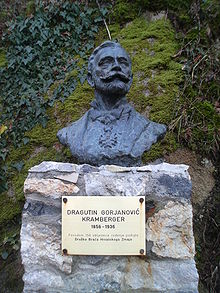Dragutin Gorjanović-Kramberger
This article needs additional citations for verification. (January 2011) |
Dragutin Gorjanović-Kramberger | |
|---|---|
 Dragutin Gorjanović-Kramberger | |
| Born | October 25, 1856 |
| Died | December 24, 1936 (aged 80) |


Dragutin Gorjanović-Kramberger (October 25, 1856, in
archeologist
.
Education
Dragutin finished his elementary education in Zagreb,
München, where his lecturer was Karl Zittel, a world-renowned expert in the areas of anatomy and paleontology. He received a doctoral degree in 1879, (Tübingen
, Germany), with work related to fossilized fishes.
From 1880, he was
family name
to Gorjanović.
Lecturing
His lecturing career started in 1883 at the
vertebrates. In 1884 he was appointed assistant, later was associate, and finally full professor, in 1896. In 1893 he became head of the Geological-Paleontological Department of the Croatian National Museum. He was engaged in paleontology, stratigraphy, tectonics, paleoclimatology, applied geology, geological mapping, and hydrography
. Gorjanović-Kramberger discovered, described, classified, systemized, aged, and determined environments for numerous new species of fossilized fishes. As a young scientist at the end of the 19th century, he had already published more than fifty works in prestigious European scientific journals.
Krapina
In 1899 on Hušnjak hill, near the Croatian town of
fauna, ecological conditions, and the life and culture of people once living in Croatia. While analyzing the finds, he noticed unusually big variations among the bones.[2]
With time he realized that
Homo neanderthalensis
. Gorjanović-Kramberger's research helped prove the theory of evolution of human species, and his theories have influenced the social view of the world.
He started the study of skeletons relating to modern humans and developed a technique that analyzes the
X-rays to analyze inner bone structure. Results of his research related to the finds at Krapina could be found in the monograph "O diluvijalnom čovjeku iz Krapine", (Der Diluviale Mensch von Krapina in German; "On the diluvial man of Krapina"), which was published in Wiesbaden in 1906. The publication was the most comprehensive work ever written in the area of the paleontology of man.[citation needed
]
Works
In 1909, he founded the Geological Commission for Croatia and
pedology. The Croatian geological service became independent from the Geological Institute in Budapest
and eventually became the present-day Hrvatski geološki institut (Croatian Geological Survey) in Zagreb.
Gorjanović-Kramberger published more than 230 papers in Croatian and international journals during his career. He made a couple of geological maps. He was an honorary doctor of the University of Zagreb, a member of the Association of Medical Doctors and Croatian Natural Sciences Association, and an honorary citizen of Zagreb,
Yugoslav Academy of Sciences and Arts
. Gorjanović-Kramberger remained active after his retirement. Between 1899 and 1929, he published 53 works related to discoveries at the Krapina site.
See also
- List of fossil sites (with link directory)
- List of hominina (hominid) fossils(with images)
Notes
- ^ Krapina C Archived 2007-09-27 at the Wayback Machine at www.modernhumanorigins.net
- ^ "Culturenet.hr - The World's Largest Neanderthal Finding Site". Culturenet.hr. Retrieved February 8, 2017.
External links
- "Dragutin Gorjanović-Kramberger." In Biographical Dictionary of the History of Paleoanthropology. Edited by Matthew R. Goodrum. (2016) available at https://drive.google.com/file/d/12tWs2rELSqYExeDZ2zbfv_LsyczrLxBf/view
- Krapina Early Man
- Krapina Cave
- Archaeology
